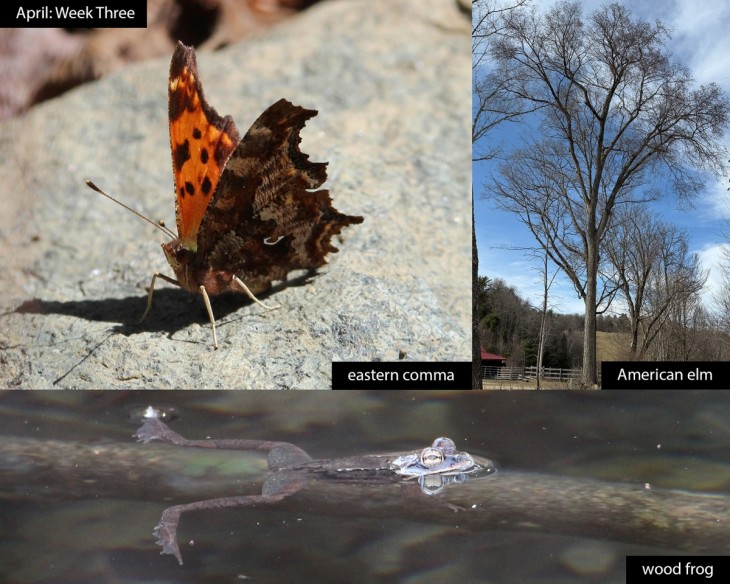This week in the woods, an eastern comma paused its erratic flight in Lyme, New Hampshire, long enough for us to see the eponymous silvery marking on its underwing. This marking helps distinguish the species from other similar “anglewings” – the gray comma, which has a thinner and unhooked version of the marking, and the question mark, which has a spot below a version similar to the gray’s. We often see adult eastern commas flying both before other butterfly species in the spring and later in the year, because they overwinter as adults – a strategy less common than migrating or overwintering as eggs, pupae, or larvae. Overwintered adults like this one will lay eggs until the end of April, and the summer form (which has slightly different markings and coloration) will lay eggs that develop into the winter brood, which will in turn spend the cold months in diapause, sheltered in tree and rock crevices, logs, and cracks in buildings. Adults feed sometimes on nectar but mostly on fermenting fruit, tree sap, animal scat, mineral residue from puddles, and carrion, and they occupy sunny forest clearings (often near water) rather than open fields.
One of the eastern comma’s host plants is the American elm, once a dominant part of the butterfly’s woodland habitats but severely diminished since the onset of Dutch elm disease in the 1930s. As Madeline Bodin explains in this Outside Story article, the fast-growing species is tolerant of both spring flooding and summer drought and was especially crucial as a canopy tree in floodplain forests. The tree also has a strong association with human settlement, and many survivors persist on town greens and near old homes. Early European settlers looked for sites with elms, which they knew would have moist, fertile soil. In the 19th and 20th centuries, the tough tree benefited from urbanization, and elms planted as shade trees lined the streets of eastern and Midwestern towns and cities such as New Haven, Connecticut, once nicknamed “Elm City.” This iconic, feather-duster-like specimen has hung on along a roadside in Topsham, Vermont. If you know of a similarly large surviving American elm (at least 22 inches diameter at breast height), reporting it to the USDA Forest Service’s Northern Research Station can aid efforts to identify disease-resistant trees.
The quacklike calls quieted as we approached a spring-fed pool, but with some stillness, and patience, this wood frog surfaced for us to see. These frogs have spent winter in glucose-infused torpor, partially frozen in cavities beneath a few inches of forest floor or mud at wet meadow edges. The first warm rainy spring night, before bullfrogs and green frogs emerge from their own hibernations, can prompt wood frogs to thaw out in a matter of hours. Known as “explosive breeders,” they awaken immediately ready to mate and make their way to the seasonal pools or small, fishless ponds where they began their lives. Here, pairs breed and lay masses of up to 2,000 eggs each.
What have you noticed in the woods this week? Submit a recent photo for possible inclusion in our monthly online Reader Photo Gallery.


